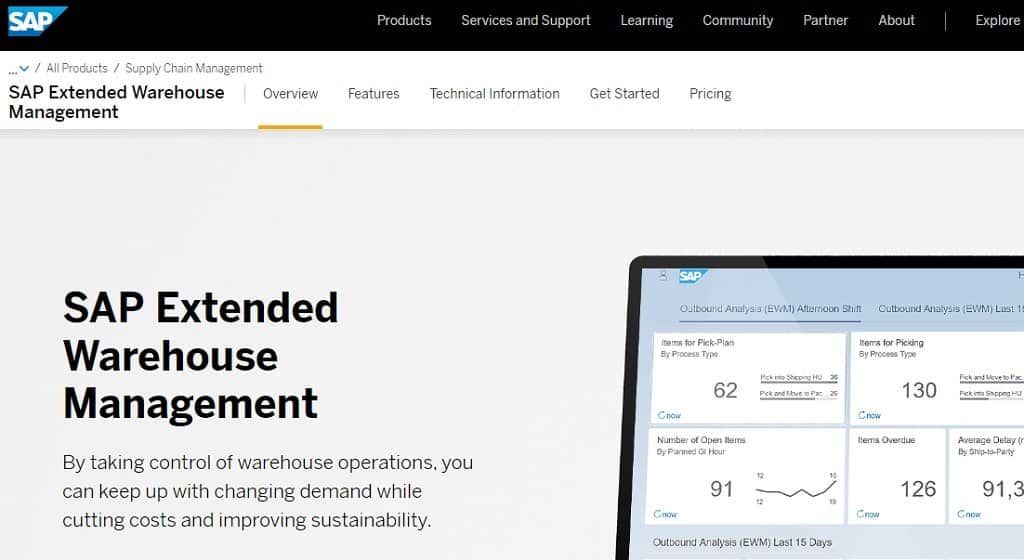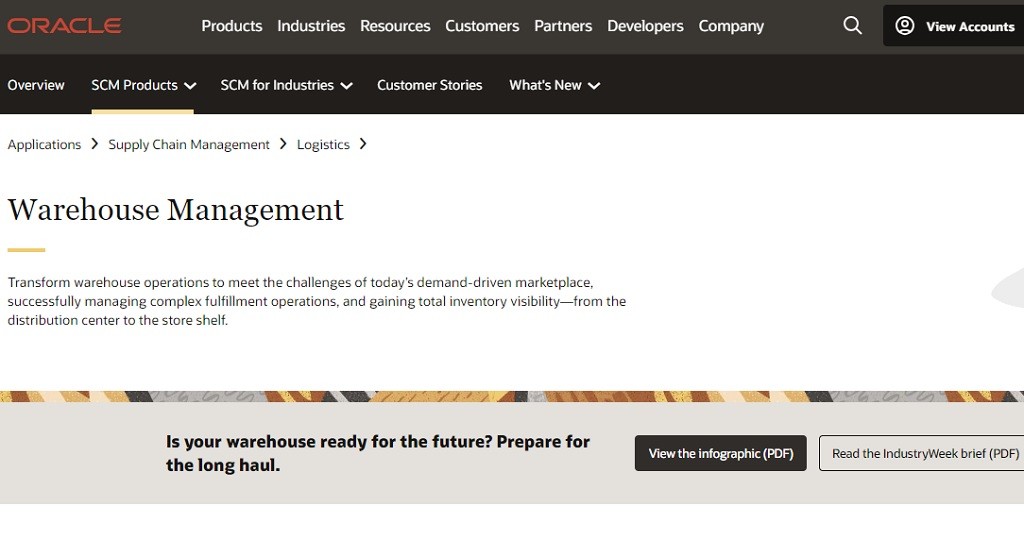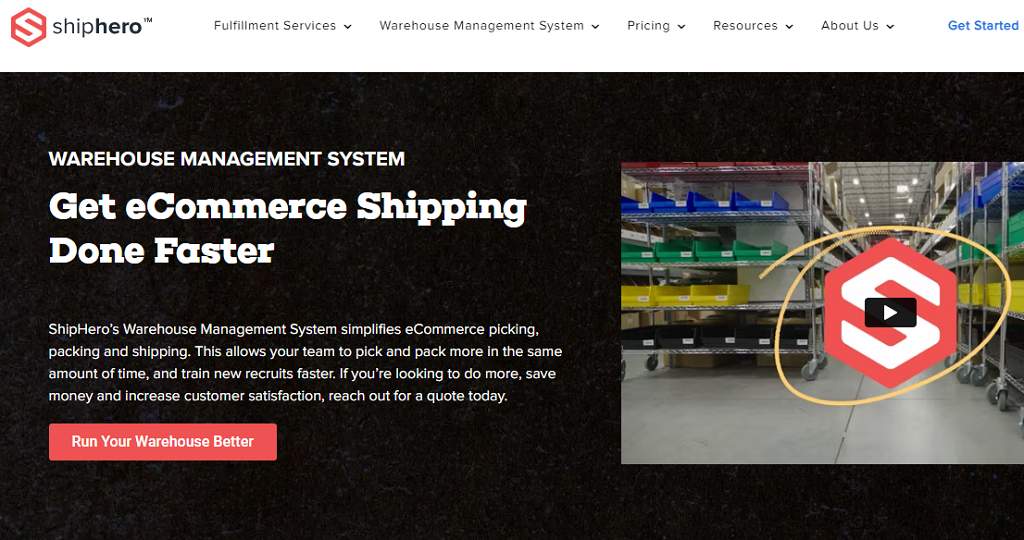How to choose a 3PL Warehouse Management System
One of the most difficult challenges in both omnichannel and ecommerce fulfillment is managing and tracking inventory at scale.
Most Third-Party Logistics (3PL) providers serve multiple client businesses, each with its own specific needs, requirements, and processes.
3PL operations are fast-paced by nature and require a state-of-the-art Warehouse Management System (WMS) software solution.
Why? 3PLs depend on effective and efficient warehouse management software to run a complex system of warehouse operations, keep costs low and customer service high, and provide the data transparency their clients need for successful decision-making.
If you’re a 3PL provider, you may wonder how a WMS can make your business more efficient, save time and money, and provide better customer service for your clients. With that in mind, let’s dive in to the benefits of this software and how to choose a 3PL warehouse management system that works for you.

What is a Warehouse Management System (WMS)?
WMS is a software system that is utilized to effectively manage and track nearly all activity inside the warehouse. This ranges from physical inventory management to shipping and receiving, as well as picking, packing, and processing returns.
A WMS increases both the productivity and efficiency of a 3PL company’s warehouse operations by increasing the speed of work routines via streamlined picking, packing, shipping, and reverse logistics procedures.
Additionally, for 3PL companies that serve multiple clients in the same warehouse, a WMS can easily track the inventory of each client or customer.
A WMS can effectively manage ecommerce operations and integrations with shopping cart platforms as well. These state-of-the-art systems are designed to not only communicate with both your customers and vendors but also integrate easily with a wide variety of platforms and software systems, including:
- Barcode Scanning Systems
- ecommerce Platforms such as Amazon and Shopify
- Transportation Management Systems
- Enterprise Resource Planning Systems
- Supply Chain Management Systems
- Inventory Management Systems
The three types of Logistics Management Software
The varied components of the supply chain, or the network between a business and its suppliers to produce and distribute its product(s), are complex, multi-faceted, and rife with opportunities for error from supplier to ultimate consumer.
Fortunately, advanced WMS software systems make it possible for 3PL suppliers to streamline their businesses, easily integrating with outside platforms and software and automating key components of their order fulfilment operations.
There are three main types of logistics management software: standalone Warehouse Management Systems (3PL WMS), Enterprise Resource Planning (ERP) Systems, and Integrated CSM Suites. Let’s explore them further.
Standalone 3PL Warehouse Management Systems
Standalone 3PL Warehouse Management Systems (3PL WMS), such as SkuVault Core, increase both the productivity and efficiency of your 3PL company’s warehouse operations. In terms of 3PL warehouse management, the software allows third-party logistics providers to manage a wide variety of warehouse operations, from shipping, tracking, and receiving stock at the warehouse through the process of fulfillment and shipping orders until your client’s product reaches their customer’s doorstep.
Standalone WMS software pinpoints inefficiencies and helps to escalate the speed of employees’ work routines, as well as streamline the picking, packing, and shipping process to minimize labor costs without sacrificing quality or customer care.
Although there are differences in various warehouse management software options, there are some key features that many of these sophisticated software systems have in common.
First, warehouse design features can customize workflow at your facilities in order to both maximize your storage space, as well as make picking, packing, and shipping more efficient, saving your company money. Second, a standalone 3PL WMS accurately and efficiently tracks your clients’ inventory in real-time, from shipping stock to the fulfillment center, to ensure your client’s bestselling items are always in stock, to generating packing lists, and sending shipping notifications to your client’s customers.
Standalone WMS software can also maximize labor management to reduce costs, offer radio-frequency identification (RFID) support, and provide your customers with in-depth analytics and reporting, all through their own customized dashboard.
Enterprise Resource Planning (ERP) Systems
Enterprise Resource Planning (ERP) Systems integrate essential business processes, such as accounting, customer relationship management, inventory, order fulfillment, and human resources across different modules.
ERP systems offer a variety of features, however, they all include a shared database easily accessible and utilized by employees across the company’s various divisions (such as sales, marketing, or shipping.)
The shared, company-wide database offers both synchronized reporting and automation. This allows employees to generate real-time reporting and analysis seamlessly from a single system instead of manually merging data from multiple database sources. In addition to streamlining operations, ERP systems can increase both efficiency and accuracy across the board.
Integrated Supply Chain Management (SCM) Suites
Integrated Supply Chain Management (SCM) software suites manage the entire supply chain beginning with product development, raw materials, and production to logistics, inventory management, warehousing and fulfillment operations, shipping, and ending with delivery to the customer’s doorstep. A SCM software suite manages the supply chain from beginning to end, tracking data, inventory, finances, and shipments as they move through the chain.
SCM software suites integrate all of a company’s planning and execution of supply chain processes and activities required to manage the movement of materials, information, and financial capital for improved efficiency, agility, and transparency. These activities can include:
- Demand Planning
- Materials Sourcing
- Production of Goods
- Inventory Management
- Logistics
- Reverse Logistics (returning defective products or excess inventory)
Effective supply chain management relies heavily on collaboration along the chain, specialized SCM software, and effective business strategy.
Additionally, SCM software suites enable the utilization of the electronic data interchange (EDI) system in order to increase efficiency in data transfer between supply chain partners.
Advanced SCM software suites integrate all supply chain activities from manufacturing and logistics to fulfillment and shipping, to create better collaboration, communication, risk management, and adaptability among company divisions and partners.
This improves agility and transparency throughout the process, which lowers operational costs and increases efficiency throughout the supply chain.
What are the benefits of using 3PL software?
The benefits of using SkuVault’s software for 3PLs are numerous, including time and cost savings, fewer errors, fewer out-of-stocks and mis-ships, and real-time stock status.
3PL software also provides reduced shipping costs, lower labor costs, more quality control, and faster order fulfillment, which translates to higher customer satisfaction. WMS software partners help their clients transform their businesses to operate more efficiently and grow faster.
Saving time and money through automation
3PL software can save both you and your clients time and money by automating tasks such as fulfillment, invoice, purchase order, and report generation, as well as integrations with ecommerce platforms like Amazon and Shopify. This gets your clients’ orders to their customers more quickly, maintains stock of your clients’ most popular and best-selling items, and ensures on-time delivery which means fewer returns and higher satisfaction.
Improved customer service and reduced costs from order to customer
Helping your clients to streamline their processes means reduced costs for you and them, lower shipping costs, fewer mistakes during fulfillment, faster returns, and better customer service for everyone.
Easier returns processing
You can seamlessly process your business customers’ returns, both improving their customer satisfaction and returning products to their inventory quickly. Returned goods are quickly assessed for damage to determine whether they may be returned to inventory.
Lower risk for error
Automation significantly reduces human error in the order fulfillment process. With effective WMS software, data is utilized for greater speed and accuracy, both for your 3PL business and for your clients.
Real-time stock visibility
Your clients can get real-time visibility of their inventory, as well as notifications when stock is running low, and the flexibility to create purchase orders at any time of the day or night. Customized sales reports allow your clients to see their sales by any timeframe or sales channel.
Your customers can avoid both overselling inventory and directly integrate with purchase orders. In addition, your clients can generate pre-sale income by selling against inventory in transit, or utilize demand planning to make more efficient purchasing decisions.
Increased transparency
When your clients trust you for their 3PL needs, having the technology to track your performance as well as their own sales and inventory creates an environment of greater trust, accountability, and satisfaction.
Customization and scalability
3PL software can be customized and scaled to suit the needs of individual clients, from labels and reports to operational processes and billing. And, when your client grows their business, adds inventory, or enters another market the software scales easily for your needs (and theirs.)
Faster selivery
Because WMS software makes order fulfillment more efficient, shipping speed is increased, which means more satisfied customers for your clients’ business.
Insight Into Your Business
One of the most significant benefits of SkuVault’s 3PL software is the insight into your business, which can illuminate opportunities that might otherwise have been missed. Integrating your client’s supply chain, warehouse activities, and shipping provides a more holistic view, and your clients will be able to track their inventory, review performance, and generate reports on demand.
What to consider when deciding on the right 3PL software
Finding the right WMS software is critical because order fulfillment is the lifeblood of any business. When choosing a 3PL warehouse management software, such as SkuVault Core for WMS, to streamline your business and serve your clients, you’ll want to keep these things in mind:
1. Cutting Edge Technology
When your clients depend on you for their company’s order fulfillment process, make certain that the company providing the WMS has the best technology available. Modern WMS technology can increase efficiency, save money, and both streamline and automate warehouse processes to reduce costs and errors.
2. Multiple client architecture
For 3PL providers, warehouse management software must be able to manage inventory and order fulfillment for multiple clients or divisions. In addition, features including client logins and dashboards, and the ability to view and generate their own stocks and dashboards are key to success.
3. Labeling compliance
Whether your clients are shipping across the country or the globe, as a 3PL provider your WMS must effectively manage product packaging and labeling regulatory requirements. WMS software easily administers labeling requirements, making certain your customers’ businesses are always in compliance.
4. Scalable functionality
As your business grows, you’ll need a 3PL software that can grow to meet the needs of your clients as they arise, and a 3PL warehouse management system works on a ‘pay-as-you-go’ model. This means you can easily adjust to your clients’ seasonal fluctuations and business growth without sacrificing customer service or efficiency.
5. Easy automation
One of the key benefits of 3PL software is the ability to quickly set rules for a variety of conditions to determine how your client’s orders are prioritized, packaged, and shipped.
6. Billing made easy
Your WMS billing functions are crucial to ensure that invoice payment is always accurate and timely.
7. Value for your clients
As a 3PL provider, your WMS software solution must minimize your company’s costs while maximizing speed, accuracy, and efficiency for your clients.
What features should you look for when choosing a 3PL Warehouse Management System?
Not all 3PL warehouse management systems are alike. At a minimum, your WMS should include:
- Inventory management, including the ability to segregate inventory by owner
- Packing, picking, and shipping functionality
- Reporting tools with individual client login and dashboards
- A dock door appointment scheduler, and shipping and receiving functionality
- Inventory control, including low inventory warnings and inventory transfer functionality
- Comprehensive warehouse management operations (including cycle counts)
- Ability to integrate seamlessly with other software and systems
- 3PL billing
- 3PL software scalability and customization
Our top 5 3PL Warehouse Management System picks
SkuVault Core
SkuVault Core is a cloud-based 3PL warehouse management software brought to you by one of the industry’s leading software vendors. Our comprehensive WMS is designed to help businesses, including third-party logistics companies, manage their inventory more effectively.
SkuVault integrates seamlessly with numerous ecommerce platforms, shopping carts, marketplaces, and point-of-sale systems. Our customers love us for our real-time quantity syncs, helping them reduce stocks and over-sells and increasing their profitability.
Key features
- Real-time inventory tracking and visibility across multiple locations
- Quality control at the pick and pack stage
- Advanced reporting and forecasting
- ecommerce integrations with platforms like Amazon and Shopify
- Barcode scanning capabilities for efficient order processing
- User-friendly interface
SAP Extended Warehouse Management (EWM)
SAP EWM is a powerful third-party logistics WMS from the software vendor SAP. As part of SAP’s Supply Chain Management suite, it provides advanced warehouse management capabilities catering to the needs of complex 3PL organizations.
It provides flexibility in managing inventory in the warehouse and supports all warehouse activities, including inbound and outbound processing, warehouse structure, and more.
Key features
- High-volume warehouse processing and complex supply chain logistics
- Labor management and demand planning
- Cross-docking and yard management
- Integration with other SAP modules and non-SAP software
- Advanced analytics and reporting
- Automated material handling equipment integration
Oracle Warehouse Management
Oracle Warehouse Management, a component of the Oracle E-Business Suite, is a robust solution offered by the software vendor Oracle.
It provides advanced warehousing, inventory management, and supply chain capabilities designed to support various business models, including third-party logistics companies. Its flexible architecture enables high levels of automation and customization.
Key features
- Task management for efficient warehouse operations
- Inventory visibility and control across supply chains
- Automated data collection
- Support for multiple order fulfillment strategies
- Integration with other Oracle products
- Mobile capabilities for real-time data access
ShipBob
ShipBob is a modern ecommerce fulfillment platform from a renowned software vendor. The platform provides robust inventory management and order fulfillment capabilities, making it a great candidate for 3PLs.
Businesses can store inventory in ShipBob’s warehouses worldwide, reducing shipping costs and times. Furthermore, it integrates with popular ecommerce platforms and marketplaces.
Key features
- Distributed inventory and order management
- Real-time analytics and reporting
- Returns management
- B2B and wholesale order fulfillment
- Batch and expedited order processing
- Integration with popular ecommerce platforms like Shopify, WooCommerce, and Amazon
ShipHero
ShipHero is a comprehensive, cloud-based 3PL warehouse management system known for its robust features that enable eCommerce businesses to manage their inventories efficiently.
This software stands out with its order management and batch-picking features, significantly reducing the time required to process orders.
Key features
- Real-time inventory management
- Automated order routing and batch picking
- Customizable packing slips and labels
- Reporting and analytics tools
- Integration with various shopping carts, marketplaces, and carriers
- Mobile app for iOS for flexible operations
Choosing the right WMS depends on various factors, like the size of your operation, the nature of your products, your budget, and the level of customization you need.
Considering these key features will help you select the software that best aligns with your business needs.
Final thoughts
3PLs serve their clients by providing warehouse services without the need for them to invest in expensive fulfillment facilities or logistics management.
To keep your customers satisfied and their businesses (and yours) growing, utilize the advantages of SkuVault’s 3PL WMS software capabilities to streamline your business and increase your operation’s efficiency.
Ready to give SkuVault a try for yourself? Take an interactive product tour now.







